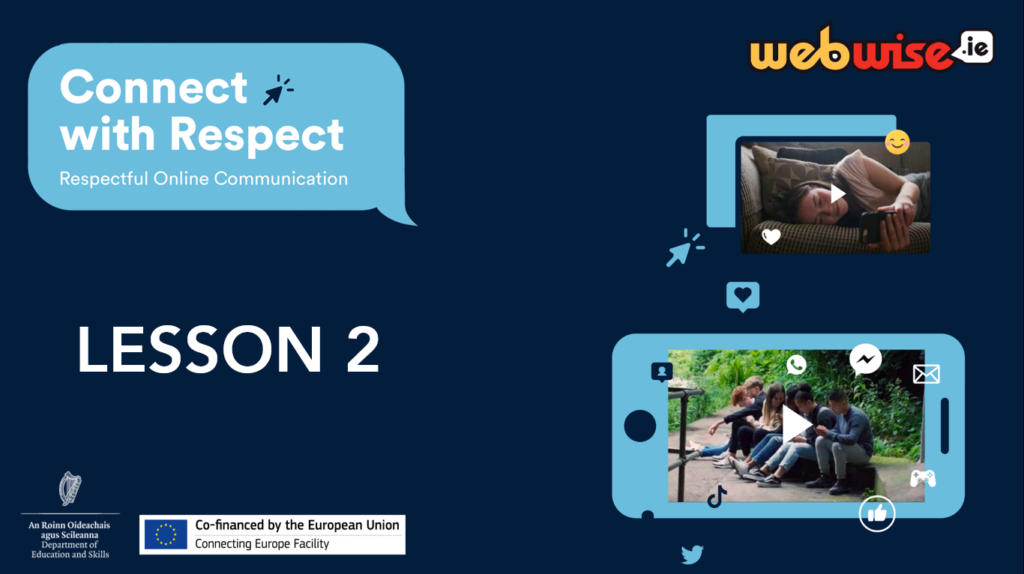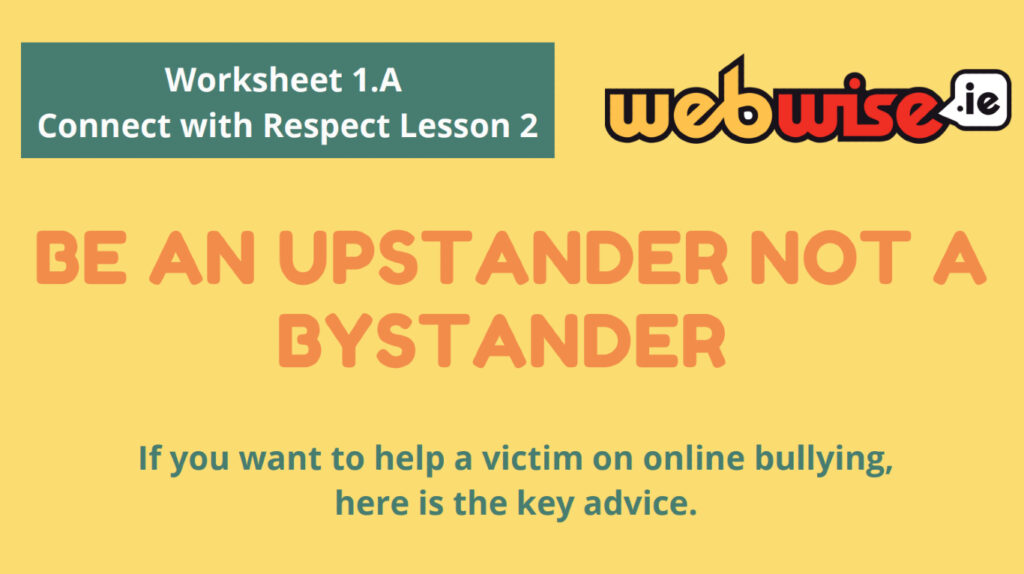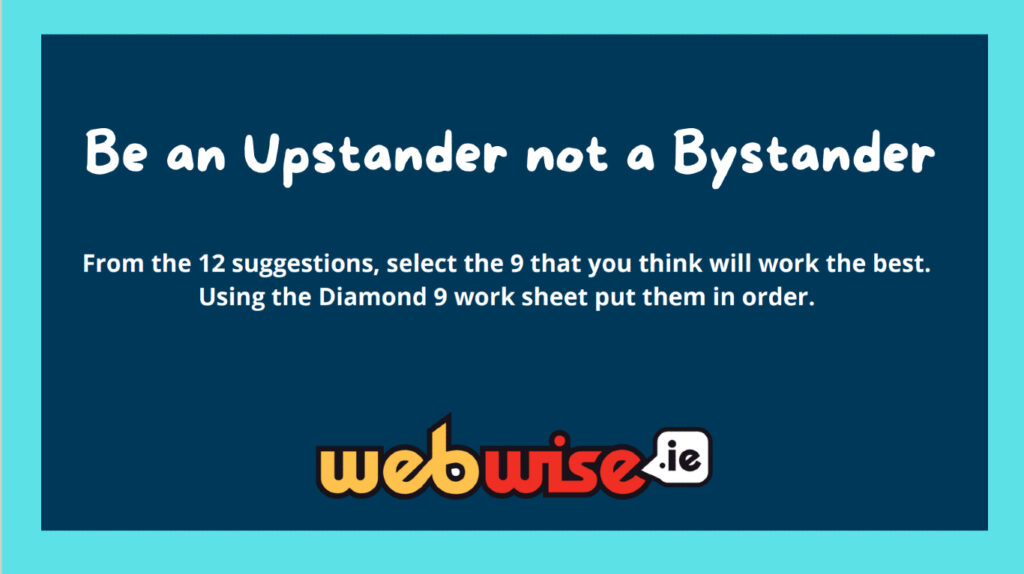Follow on Lesson – Connect with Respect

Follow on Lesson – Connect with Respect
Core Concept: This lesson examines the roles of the different people involved in bullying and how bystanders can be encouraged to intervene. The lesson aims to enable students to develop responsible decision-making when they witness it taking place.
Key Learning for Students: Students will be able to describe the procedures that should be followed by bystanders to put a stop to bullying. Students will have the confidence to intervene and will know how to get help when they encounter incidences of bullying.
Resources needed and Methodologies
Resources needed
– Connect with Respect Power Point Presentation and Script
– Webwise Bystander advice: https://www.webwise.ie/parents/watch-your-space-the-bystander-advice-2/
– Sticky notes (Post-its)
– Worksheet 1 and 1A
Methodologies
Discussion, group work, diamond 9 activity
Activity 1 – Bullying – Who’s Involved?
Begin with a recap of the Connect with Respect Garda Schools Lesson and the key points:
– What is cyberbullying?
– What constitutes cyberbullying?
– How can we respond?
– Where can we get help?
Slide 4: Introduce the concept of being an upstander and being a bystander when online.
Ask students if they are aware of the term bystander and upstander.
Upstander OR Bystander:
Bystander: Bystanders are people who witness bullying but are not victims or perpetrators of bullying. The bystander effect means that often the more people who see something happen the less likely each individual is to do something about it.
Upstander: Someone who not only recognises when something is wrong, but as a result, stands up for his/her beliefs by taking action. An upstander will help/support whomever is being hurt, or will speak up to correct the situation/make it right.
Slide 5: Students should then consider the following questions:
What might prevent people from intervening in bullying situations?
Suggested answers:
– People might be prevented from intervening because they fear being bullied next.
– They think they don’t know the full story and so avoid getting involved.
– They are threatened when they try to help out.
– They don’t know what to do.
– They don’t recognise the bullying behaviour.
– They want to stay ‘in’ with the popular crowd.
– They don’t want to take sides.
– They are involved in bullying and fear they’d get in trouble if they intervened.
How can bystanders get help without exposing themselves?
Suggested answers:
Bystanders can help by reporting cyber bullying online. This is usually an anonymous process. Bystanders can also help by telling a student mentor or responsible adult about the bullying incident. The bystander can stress that they would like to remain anonymous to prevent the bullies from targeting them next. The bystander can help improve the situation by reaching out and supporting the person who is being bullied. Speaking up in a calm supportive way but not retaliating online will let the bullies know that their behaviour is being noted and that it is not condoned. Privately supporting the person who is bullied might give this person the courage to seek help.
How do people who bully benefit when someone acts as a positive bystander?
Suggested answers:
These people benefit when someone acts as a positive bystander as bystander interventions help bring problems to the surface and lead to positive resolutions. Oftentimes the reason why people bully is that they are experiencing difficulties themselves. When a bystander intervenes, this can result in the person who bullies receiving the support they need. Bystander interventions also help bring an end to conflict that might actually have been distressing the person who bullies.
Activity 2: Be an upstander not a bystander
The symbol on the left is a QR code. It is like a barcode that can be scanned to bring you to a website. By opening the camera on your phone and holding it over the image it can open the webpage I want to bring you to. If that is not working please type in the web address under the image. This is a website called webwise.ie. This is a state funded support service that provides information and advice for young people on a range of internet safety issues and concerns. The page I want you to examine is a list of suggested ways that young people can be upstanders online. There are 12 suggested things here that you can do. In your groups I want you to go through these suggestions and select the 9 that you think will work the best. Using the Diamond 9 work sheet put them in order. The most important factors are placed towards the top of the ‘diamond’ and the least important factors towards the bottom. Factors of equal importance are placed on the same row.
This will require discussion and compromise. It’s important to be able to explain your placement and reasoning for doing so.
This activity is designed to get the students familiar with the Webwise website but also to get them discussing ways that they can help create a safer better internet. This could take about 10-15 minutes. With the teacher circulate the room and ask probing questions. What do you think of this point? How might that work? Why have you placed this idea in that slot? Etc.
If the students cannot use devices to access the website please print off worksheet 1A and give it out to the groups to use instead.
Ask students to write the key advice titles from Worksheet 1A on post-its and place them on the diamond. Following discussion, allow students time to change or re-consider their placements.
Where the students place the ideas is not really important, the learning here is in the discussion. If you have time get them to walk around and look at what other groups have worked on.
Activity 3 – Conscience Alley
Next, introduce the Conscience Alley activity – tell the students they are now going to hear a dilemma in which they will have to offer advice on the best way to resolve it.
– Split the group in half, asking them to form 2 lines facing each other – this is the ‘alley’. Ask, one person to act as the decision maker aka the friend of the main character in this dilemma and instruct them to stand at the beginning of the ‘alley’ or 2 lines facing each other.
Alternatively if space is limited, have students sit in groups of 4/5 and allocate each group with the upstander or bystander roll. The group must come up with persuasive reasons, and persuade the one student who walks from group to group.
– Remind students to listen carefully as you read out the dilemma to the group:
Dilemma: Sean has confided in his friends that he has taken his relationship with Bronagh to the next level and they are sexting. The other guys in the group are calling Sean a liar and pressuring him to send pics of Bronagh to their group chat as proof. Sean gives in and posts the pic. You are in the group chat and friends with both Sean and Bronagh – and feel uncomfortable with the what has happened. Do you report it or say nothing?
Then, tell the right side they will be represent the upstander voice – giving reasons for why the friend should act as an upstander and report what has happened. The left side will represent the bystander voice – giving suggestions for why the friend should just say nothing about what has happened. Give the members of both sides a moment to think about what they will advise Sean’s friend to do.
– Instruct the person playing Sean’s friend to walk between the lines and as he/she does each member of both sides gives their advice – either why he/she should report what has happened or say nothing. As he/she reaches the end of the tunnel tell them to join one of the lines to indicate the choice they have made. Then ask him/her why they made that decision – which side’s advice persuaded them the most.
*If this person being asked to make the decision is still not sure what side to pick – to either be an upstander or bystander ask them to walk back through the tunnel again and the sides to give more advice.
When sharing personal information/photos/videos online always remember: The Granny Rule – If you wouldn’t show a picture to your granny then it probably shouldn’t be online!
Note for Teachers
It is important that the safety of the bystander is always considered.
– Bystanders should never be put in a position where they are in danger of being the subject of physical abuse or aggression.
– It’s also important that bystanders are strong, assertive and positive in intervening in bullying situations and that they don’t respond to the bullying in an aggressive way that could itself be considered bullying.




